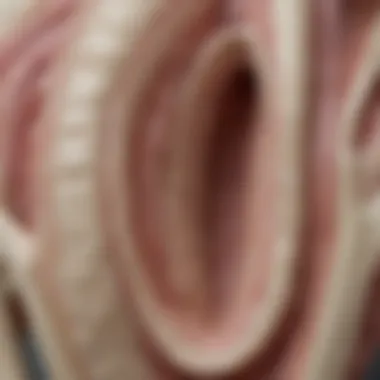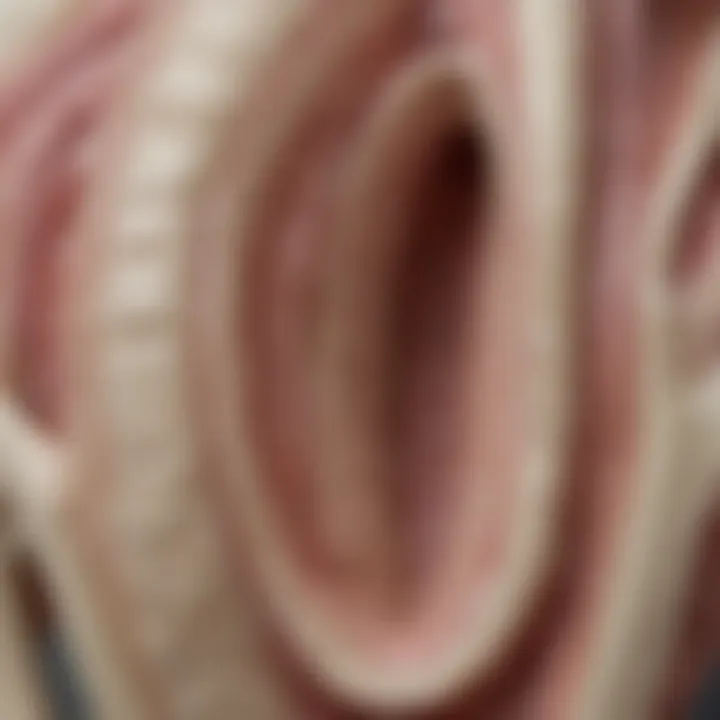Understanding Tietze Syndrome: An In-Depth Analysis


Intro
Tietze Syndrome is a topic often overlooked in medical discussions, yet it holds significant importance for those affected. Characterized by inflammation of the costal cartilage, specifically at the costosternal, costochondral, and costovertebral joints, this condition presents with distinct symptoms that warrant attention. Understanding this syndrome is crucial for healthcare professionals, students, and anyone interested in musculoskeletal disorders.
In exploring Tietze Syndrome, we delve into its clinical presentation, potential causes, diagnostic methods, treatment options, and the overall impact on patients’ quality of life. The insights gathered here aim to educate and foster better management practices for those impacted by this syndrome, laying the groundwork for informed discussions and enhanced understanding within the medical community.
Article Overview
Summary of Key Findings
The key findings regarding Tietze Syndrome illuminate vital aspects of the condition:
- Definition and Characteristics: Tietze Syndrome is marked by localized pain and swelling near the sternum. It primarily affects young adults and often resolves within a few weeks to months.
- Symptoms: The hallmark symptoms include chest pain, tenderness to palpation, and sometimes associated swelling of the cartilage.
- Diagnostic Challenges: Differentiating Tietze Syndrome from other similar conditions such as costochondritis is essential to establish appropriate treatment.
- Treatment Options: Management can involve non-steroidal anti-inflammatory drugs (NSAIDs), physical therapy, and in some cases, corticosteroid injections.
- Quality of Life Impact: For patients, living with Tietze Syndrome can lead to anxiety about underlying health problems and limitations in daily activities.
Research Objectives
The objective of this article is to present a thorough examination of Tietze Syndrome through a structured approach, targeting several dimensions:
- To clarify the nature and characteristics of Tietze Syndrome.
- To analyze current diagnostic methods and their effectiveness in distinguishing the syndrome from similar ailments.
- To discuss treatment modalities and their role in managing symptoms.
- To evaluate the overall implications of Tietze Syndrome on patients’ daily lives, enhancing understanding among various stakeholders in the healthcare field.
Prolusion to Tietze Syndrome
Tietze Syndrome is a clinical entity characterized by inflammation of the costal cartilage. Understanding this condition is essential, as it provides insights into its clinical presentations, potential diagnostic methods, and management strategies. A comprehensive understanding of Tietze Syndrome not only benefits healthcare professionals but also enhances awareness for educators and researchers in the field.
Definition and Origin
Tietze Syndrome refers to the inflammation of the costal cartilage, particularly at the junction where the ribs attach to the sternum. This inflammation can lead to localized pain and swelling. First described by the German surgeon Alan Tietze in 1921, the condition has since been recognized and acknowledged in the medical community, although specific details surrounding its etiology remain somewhat elusive. The exact cause of Tietze Syndrome is not well understood, but it is often linked to repetitive trauma or physical strain.
Historical Context
Understanding the historical context of Tietze Syndrome sheds light on the evolution of medical knowledge regarding this condition. While Tietze was the first to describe this syndrome, earlier medical literature referenced similar symptoms without defining them as a unique syndrome. In the decades that followed, research into costochondritis and related syndromes flourished, leading to more refined diagnostic criteria and treatment approaches. Recognition of Tietze Syndrome has grown, although it sometimes remains under-diagnosed, as it can be easily confused with other painful conditions affecting the chest. This historical perspective emphasizes the need for continued research and education on Tietze Syndrome, ensuring that it is recognized and correctly treated in clinical practice.
"Understanding Tietze Syndrome allows for better diagnostic accuracy and management, improving patient outcomes."
In summary, the introduction of Tietze Syndrome encapsulates the necessity of awareness and understanding in a clinical context. Such knowledge promotes effective communication among healthcare professionals, facilitating informed patient care.
Clinical Presentation
The clinical presentation of Tietze syndrome is a cornerstone of understanding this condition. It helps to identify the disease, assess its severity, and tailor treatment plans. A clear grasp of the symptoms can lead to more effective communication between patients and healthcare providers. Moreover, recognizing the nuances in how symptoms manifest can assist in differentiating Tietze syndrome from other related ailments such as costochondritis or fibromyalgia.
Symptoms Overview
Tietze syndrome is marked by discomfort and pain around the chest area. The primary symptom is pain in the costal cartilage. This discomfort may be sharp or dull and can vary in intensity. Other symptoms include:
- Swelling at the affected costal cartilage
- Tenderness when pressure is applied
- Pain that might radiate to the shoulders or arms
- Symptoms may worsen with physical activity or deep breathing
Patients often find that symptoms can be intermittent, with episodes of pain appearing and disappearing. The variability makes it challenging for many to pinpoint when the discomfort will occur, which can affect their mental state.
Common Areas of Discomfort
The pain associated with Tietze syndrome usually manifests in specific areas. These often include:
- Costosternal junction: This is the most common site of pain, where the ribs attach to the sternum.
- Costochondral junction: Pain may occur where the ribs meet the cartilage.
- Costovertebral joints: Some individuals report discomfort radiating towards the back.
It is crucial to observe that the intensity of the pain can vary greatly among individuals. Some may experience significant discomfort even with minor activities. Others can manage with little disruption to their daily routine.
Impact on Daily Activities
The impact of Tietze syndrome on daily life can be considerable. Individuals may find it difficult to perform normal activities due to the recurring pain. Common challenges include:
- Physical limitations: Many patients struggle with activities requiring upper body movement, such as lifting or reaching.
- Work disruptions: If the pain is persistent, people may need to take time off work.
- Lifestyle alterations: Simple activities like exercising or engaging in hobbies may become daunting, leading to decreased quality of life.
It is important to note that evaluating the full impact of Tietze syndrome requires a well-rounded approach, considering both physical and emotional dimensions.
Understanding the clinical presentation of Tietze syndrome provides insights into how to recognize and address the condition holistically. A thorough comprehension of the symptoms and their effects is essential in improving clinical outcomes and patient well-being.


Differentiation from Similar Conditions
Differentiating Tietze Syndrome from similar conditions is crucial for accurate diagnosis and effective treatment. Many patients with chest pain may present symptoms that overlap with other disorders. By identifying the unique characteristics of Tietze Syndrome, healthcare professionals can provide proper care and potentially avoid unnecessary interventions or misdiagnosis. The subtleties in symptoms and clinical presentations of related conditions warrant careful analysis.
Costochondritis
Costochondritis is often confused with Tietze Syndrome due to similar symptoms. Both conditions involve inflammation of the costal cartilage, leading to pain in the chest area. However, costochondritis is generally characterized by
- tenderness at specific cartilage joints
- absence of swelling or may exhibit minimal inflammatory responses.
In contrast, Tietze Syndrome is distinguished by visible swelling and typically affects the second to fifth ribs. Careful examination of these differences is important for effective treatment strategies.
Fibromyalgia
Fibromyalgia presents a broader spectrum of symptoms that can mimic those of Tietze Syndrome. Patients suffering from fibromyalgia often complain of widespread pain, fatigue, and even sleep disturbances. Key aspects that set Tietze Syndrome apart include:
- localized pain that intensifies with palpation
- the absence of other systemic signs usually associated with fibromyalgia, such as fatigue or cognitive dysfunction.
Understanding the specific pain pattern and distribution helps in identifying Tietze Syndrome rather than merely attributing symptoms to fibromyalgia.
Rib Fractures
Rib fractures can also present with severe chest pain, making it yet another condition to distinguish from Tietze Syndrome. Patients with rib fractures typically report:
- sharp pain that worsens with movement
- possible bruising or deformity in the affected area.
Testing for fractures, often through imaging techniques, can confirm the diagnosis. In contrast, Tietze Syndrome will not show any fractures in the ribs but may still demonstrate tenderness and swelling in the cartilage.
Having a clear understanding of the differences between Tietze Syndrome and these similar conditions enables healthcare providers to approach treatment effectively. Accurate diagnosis leads to suitable management plans that minimize discomfort and improve patient well-being.
Etiology of Tietze Syndrome
Understanding the etiology of Tietze Syndrome is crucial for establishing effective treatment strategies and improving patient outcomes. Identifying the potential causes can lead to better diagnostic practices and targeted therapies. This section covers various factors that may contribute to the development of Tietze Syndrome, including physical trauma, genetic predispositions, and other underlying mechanisms.
Potential Causes
Tietze Syndrome, while often idiopathic, entails various potential causes that may trigger its onset. Some of these potential causes are:
- Trauma or Injury: Physical trauma is one of the most commonly cited reasons behind this syndrome. An impact or repetitive strain to the chest area can lead to inflammation of the costal cartilage.
- Infections: Certain infections, such as viral or bacterial ones, may lead to an inflammatory response.
- Inflammatory Diseases: Conditions like rheumatoid arthritis may also contribute to inflammation in the costal cartilage.
- Rare Conditions: In some instances, specific disorders that affect connective tissue could be implicated too.
Recognizing the various potential causes helps healthcare providers develop appropriate management and prevention plans.
Role of Trauma
The role of trauma in Tietze Syndrome cannot be understated. Physical trauma often acts as an initial trigger that sets off the inflammatory process in the costal cartilage. This may stem from:
- Sports Injuries: Athletes participating in contact sports, such as football or rugby, may experience direct impacts to the chest that could induce Tietze Syndrome.
- Accidents: Incidents, such as car accidents, can also impose significant stress to the thoracic region, resulting in inflammation.
- Repetitive Movements: Certain occupations that require repetitive upper body actions can strain the cartilage over time, leading to the syndrome.
Trauma serves as a pivotal factor in triggering Tietze Syndrome, warranting attention during the diagnostic phase.
Genetic Factors
While trauma is a significant cause, genetic factors may also play a role in an individual's susceptibility to Tietze Syndrome. Certain genetic predispositions could potentially lead to a heightened inflammatory response in the body. Considerations include:
- Family History: If there is a family history of pain-related syndromes or autoimmune conditions, this could indicate a possibility of genetic involvement.
- Connective Tissue Disorders: Some individuals might possess genetic traits that make their connective tissues, including cartilage, more prone to inflammation and damage.
The exact genetic mechanisms are yet to be fully elucidated, but understanding potential genetic links could pave the way for more personalized treatment approaches in managing Tietze Syndrome.
Diagnostic Approaches
Diagnostic approaches to Tietze Syndrome are essential for distinguishing it from other similar conditions. Accurate diagnosis enables healthcare professionals to implement appropriate treatment plans, which can significantly improve patient outcomes. Understanding the diagnostic processes provides clarity on how symptoms are evaluated and what methodologies are utilized to confirm the presence of Tietze Syndrome.
Clinical Examination
The clinical examination is a critical first step in diagnosing Tietze Syndrome. During this assessment, a healthcare provider evaluates the patient's medical history and conducts a physical exam. The focus lies on palpating the costal cartilages, especially around the second or third ribs, where the tenderness is frequently most pronounced.


Key elements of clinical examination include:
- Pain assessment: The healthcare provider will inquire about the characteristics of the pain—its onset, duration, and specific location.
- Movement limitations: During an examination, the doctor evaluates any limitations in chest movement, which may indicate inflamed cartilage.
- Overall physical condition: A thorough check of any associated physical symptoms, such as swelling or tenderness around the sternum, is essential for making a diagnosis.
Imaging Techniques
Imaging techniques play a vital role in confirming Tietze Syndrome diagnosis and ruling out other conditions. Although Tietze Syndrome often appears through physical examination, imaging offers visual confirmation and insight into the structural aspects of the chest.
Common imaging techniques include:
- X-rays: These can help identify other possible causes of pain such as rib fractures. They do not usually show Tietze Syndrome but are essential for excluding other conditions.
- MRI (Magnetic Resonance Imaging): MRI is more sensitive than X-rays and can reveal inflammation of the cartilage and surrounding tissues.
- CT (Computed Tomography) scans: These provide a highly detailed view of the thoracic cavity and can be instrumental in assessing complex cases.
Utilizing these imaging techniques aids in visualizing the costal cartilage and ensuring that no other underlying issues are contributing to the patient’s discomfort.
Differential Diagnosis Procedures
Differentiating Tietze Syndrome from other similar conditions requires a systematic approach. Healthcare providers must consider various factors, including the patient’s symptoms, medical history, and results from the clinical examination and imaging techniques.
Common conditions to differentiate include:
- Costochondritis: While similar, costochondritis is generally characterized by localized pain without swelling. Unlike Tietze Syndrome, it does not involve significant inflammation of the cartilage.
- Fibromyalgia: This condition presents widespread pain, which can sometimes overlap with the pain from Tietze Syndrome, but does not typically lead to localized tenderness.
- Rib Fractures: Imaging tests can help determine the presence of fractures, which may cause pain that mimics Tietze Syndrome.
Overall, the goal of differential diagnosis is to ensure that patients receive treatment tailored to the specific condition diagnosed. By carefully analyzing each symptom and procedure, healthcare providers can enhance diagnosis accuracy.
Proper diagnosis and understanding of Tietze Syndrome influence treatment decisions and guide patient management strategies effectively.
Treatment Options
The exploration of treatment options for Tietze Syndrome is of utmost importance due to the impact of this condition on patient well-being. Effective management can markedly improve quality of life, reduce discomfort, and facilitate a person's return to normal activities. Tietze Syndrome can vary in severity, so understanding the range of treatment approaches is crucial for healthcare professionals and patients alike.
Initial Management Strategies
Initial management of Tietze Syndrome primarily focuses on lifestyle modifications and symptom relief. It's essential to establish a practical approach that can be tailored to the individual patient’s needs. Here are a few primary strategies:
- Rest: Ample rest is often recommended, especially in the case of flare-ups. This can help reduce inflammation and alleviate pain for the patient.
- Cooling Techniques: Applying ice packs to affected areas may reduce swelling and numb the pain. Typically, 15-20 minutes of application is adequate.
- Gentle Stretching: Gentle stretches can be beneficial. However, these should be approached with caution to avoid exacerbating symptoms.
"The administration of non-invasive management techniques allows for early intervention, crucial for effective long-term outcomes."
These initial strategies should be discussed alongside a comprehensive care plan with a healthcare provider.
Pharmacological Treatments
Pharmacological treatments often become necessary when initial management alone is insufficient. The pharmacotherapy plan for Tietze Syndrome often includes a blend of anti-inflammatory medications and analgesics:
- Nonsteroidal Anti-Inflammatory Drugs (NSAIDs): Medications like ibuprofen and naproxen can effectively reduce pain and inflammation in many patients.
- Corticosteroids: In severe cases, corticosteroid injections directly into the inflamed area may provide significant relief. However, this approach is reserved for specific situations due to potential side effects.
- Muscle Relaxants: For those experiencing muscular tension due to pain, short-term use of muscle relaxants may be beneficial.
Careful adherence to prescribing guidelines is important in tailoring an effective pharmacological treatment regimen. Regular assessments may be necessary to adjust medications and monitor side effects.
Non-Pharmacological Approaches
Non-pharmacological approaches complement traditional medical treatments and help develop a holistic management plan. Some of the most recommended techniques include:
- Physical Therapy: Engaging a physical therapist can aid in developing a personalized exercise program. This incorporates strengthening, flexibility, and functional training.
- Therapeutic Massage: Massage therapy may alleviate the muscle tightness and soreness associated with Tietze Syndrome, enhancing relaxation and promoting blood flow to the area.
- Acupuncture: Some patients find acupuncture to be an effective method for alleviating pain and inflammation.
- Mindfulness and Stress Management: Techniques such as meditation, yoga, and deep breathing exercises can significantly affect pain perception and overall coping strategies.
Incorporating these non-pharmacological options into a treatment plan fosters patient engagement and often leads to improved outcomes. Each patient's journey with Tietze Syndrome can differ, putting a spotlight on the importance of individualized care.
By focusing on a comprehensive range of treatment options, patients and healthcare professionals can work together to create effective management strategies to alleviate the symptoms of Tietze Syndrome.
Prognosis and Long-Term Outcomes
The prognosis and long-term outcomes of Tietze Syndrome are essential topics for both healthcare providers and patients. Understanding the trajectory of recovery and the potential for recurring symptoms can greatly influence treatment approaches and patient management.
Expected Recovery Trajectory
In most cases, individuals with Tietze Syndrome experience a favorable recovery trajectory. The inflammation associated with this condition often resolves within weeks to months. However, the duration of symptoms can vary significantly among individuals. For some, the pain may diminish quickly, while others may face persistent discomfort that requires ongoing management.


Recovery typically involves a combination of rest, physical therapy, and, in some cases, anti-inflammatory medications. Patients may notice a progressive reduction in pain and discomfort as they adhere to prescribed treatments. Education on symptom management is vital, as recognizing exacerbating factors can play a crucial role in recovery. Some patients report a gradual improvement after several weeks of intervention, while others may benefit from a multidisciplinary approach that includes pain management specialists.
"Many patients experience improvement within a few months, but understanding individual variability is key to effective management."
Potential for Recurrence
Recurrence of symptoms in Tietze Syndrome is a common concern. The risk of flare-ups varies among individuals, depending on lifestyle factors and overall health. Some may experience episodes of renewed discomfort months or even years following their initial diagnosis.
Factors that may contribute to recurrence include physical activities that strain the chest region, such as heavy lifting, certain sports, or chronic coughing. Additionally, stress can exacerbate pain perception, leading to a relapse.
- Monitoring: Regular follow-ups with healthcare providers can help in early identification of potential recurrences.
- Lifestyle Modifications: Patients are often advised to adopt measures that minimize strain on the chest area. This might include changes in exercise habits or adjustments to daily routines.
- Support Networks: Engaging in support groups can offer emotional reassurance and practical strategies for managing symptoms effectively.
Overall, while many patients can expect significant improvement, awareness of recurrence potential is essential for long-term management and quality of life.
Quality of Life Considerations
Quality of life is a crucial aspect to consider when discussing Tietze Syndrome. The syndrome can significantly impact various facets of a person's daily existence. Understanding this impact aids both patients and healthcare providers in managing the condition more effectively. By examining the consequences of Tietze Syndrome on physical and psychosocial well-being, professionals can tailor their approaches to better suit individual needs.
Physical Limitations
Patients with Tietze Syndrome often experience notable physical limitations. Pain and inflammation in the costal cartilage typically lead to discomfort during movement. Activities such as bending, lifting, and even breathing deeply can become challenging. This is particularly relevant for those who engage in physical work or sports, as pain can hinder performance and enjoyment. The limitations do not affect only physical activity; they may also reduce overall mobility.
Many patients report that even routine activities like shopping or household chores become daunting tasks. Increased pain levels during movement can create a cycle of avoidance, leading to a sedentary lifestyle. Over time, this can contribute to other health issues, including weight gain or cardiovascular problems.
Psychosocial Impacts
The psychosocial implications of Tietze Syndrome are equally profound. Chronic pain can lead to feelings of frustration, anxiety, and depression. Being unable to engage in social activities due to discomfort can isolate individuals from family and friends. This isolation may further amplify feelings of loneliness.
Patients often experience difficulty in maintaining a positive mental outlook due to the persistent nature of their symptoms. The constant reminder of physical limitations can create stress and impact relationships. It is essential for healthcare providers to not only address the physical aspects of Tietze Syndrome but also offer support for mental and emotional health.
Patients dealing with Tietze Syndrome should be encouraged to express their feelings and experiences, as emotional well-being is fundamental to overall quality of life.
Incorporating mental health support, such as counseling or social support groups, can significantly enhance the coping mechanisms for those affected. This holistic approach recognizes that managing Tietze Syndrome involves addressing both physical and emotional challenges.
Future Research Directions
The exploration of Tietze Syndrome continues to evolve, presenting numerous opportunities for future research. Understanding this condition more thoroughly can enhance treatment outcomes and improve patient quality of life. Research efforts can focus on various avenues, including the development of new therapies and deeper insights into the underlying mechanisms of the syndrome.
Emerging Therapeutics
In the realm of emerging therapeutics, new medications and treatments are being investigated. Current approaches often rely on managing symptoms, yet innovative therapies may offer more comprehensive solutions. Clinical trials are essential for examining potential new agents that target inflammation more effectively. These agents could include biological therapies aimed at specific inflammatory pathways.
Research may also look at combinatory treatments, integrating pharmacological and non-pharmacological strategies. This could mean combining anti-inflammatory medications with physical therapy or cognitive behavioral strategies. Understanding the best combinations can lead to new guidelines and care practices for Tietze Syndrome.
Understanding Pathophysiology
Delving into the pathophysiology of Tietze Syndrome is crucial for a complete understanding of the condition. Investigating the biological mechanisms that lead to the inflammation of costal cartilage offers potential insights into prevention strategies. Studies might focus on genetic predispositions that contribute to the condition's onset.
Furthermore, exploring environmental factors such as repetitive strain or tissue remodeling can provide a clearer picture of how Tietze Syndrome develops. By comprehending these elements, researchers can identify at-risk populations and potential protective factors that may mitigate the risks.
Understanding both therapeutics and pathophysiology will bridge crucial gaps in Tietze Syndrome management, fostering hope for improved futures for those affected.
In summary, future research directions in Tietze Syndrome promise not only to enhance treatment but also to provide a deeper comprehension of its causes and effects. This exploration is necessary to deliver well-rounded and effective care for individuals coping with this challenging condition.
End
The conclusion of this article is essential for encapsulating the main points discussed throughout the text regarding Tietze Syndrome. It serves as a recap and reinforces the significance of understanding this condition. This condition is often misunderstood, misdiagnosed, or overlooked in clinical settings. Thus, the conclusion synthesizes information about symptoms, diagnostic methods, treatment options, and long-term outcomes, emphasizing their importance.
The benefits of summarizing key aspects are multifold. It aids healthcare professionals in retaining critical information necessary for effective patient management. You can help in enhancing awareness about Tietze Syndrome, assuring that it receives the clinical attention it deserves.
In addition, considerations surrounding the societal impacts of Tietze Syndrome need to be highlighted. By recalling how this condition affects quality of life, both physically and psychologically, healthcare providers can take a more holistic approach towards treatment and support.
Understanding Tietze Syndrome not only involves recognizing its clinical features but also addressing its broader effects on patients’ lives.
Summary of Key Points
In this article, key points regarding Tietze Syndrome have been outlined:
- Definition and Clinical Presentation: Tietze Syndrome, characterized by inflammation of costal cartilage, manifests as localized chest pain, typically affecting younger individuals.
- Differentiation: It is crucial to differentiate Tietze Syndrome from similar conditions like costochondritis and rib fractures to ensure appropriate treatment.
- Etiology: Various potential causes have been explored, including trauma and possible genetic factors.
- Diagnosis: Effective diagnosis involves clinical examination and imaging techniques.
- Management: Treatment options range from pharmacological to non-pharmacological approaches, promoting symptom relief and managing inflammation.
- Prognosis: While the recovery trajectory is generally favorable, attention must be given to potential recurrent episodes and individual response to treatment.
- Quality of Life: Acknowledging the psychosocial impacts reinforces the need for a comprehensive care strategy post-diagnosis.
Final Thoughts on Tietze Syndrome
As we move forward, fostering informed discussions about Tietze Syndrome can help ensure that the needs of affected individuals are prioritized. Keeping knowledge current is key to managing this condition effectively. It is imperative for healthcare providers and students to engage in continuous learning to help improve awareness and treatment options.







